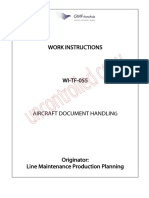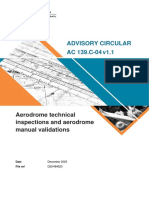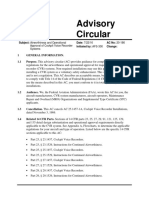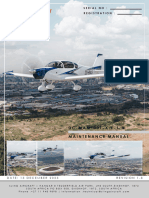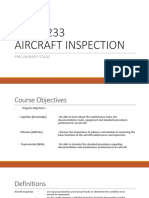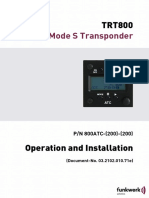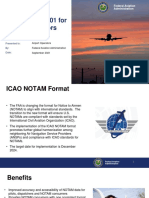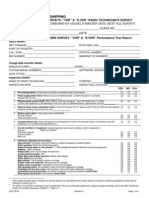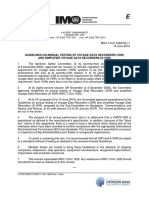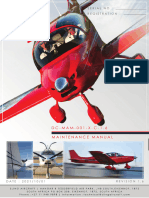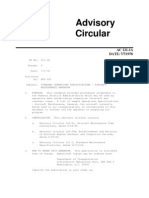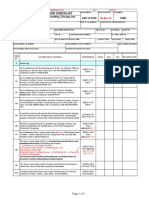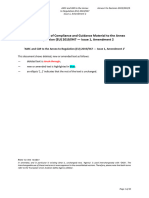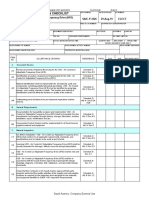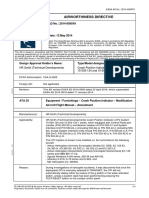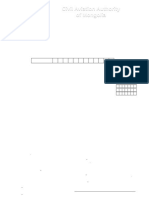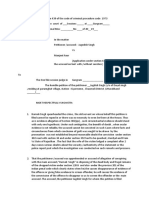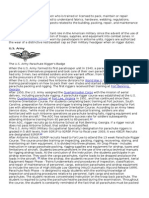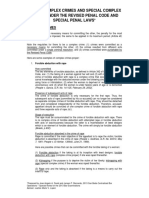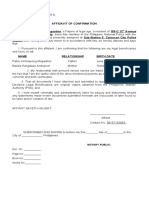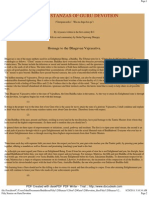FF 2
FF 2
Uploaded by
Thayagiat ChanaratCopyright:
Available Formats
FF 2
FF 2
Uploaded by
Thayagiat ChanaratOriginal Title
Copyright
Available Formats
Share this document
Did you find this document useful?
Is this content inappropriate?
Copyright:
Available Formats
FF 2
FF 2
Uploaded by
Thayagiat ChanaratCopyright:
Available Formats
FOLLOW ON FLIGHT CHECK
Scandinavian Avionics Design
Date: 27.01.2022 Document ID: 3000035-FF Issue: 2
Type: Leonardo AW139 Series System: RDR-7000 Weather Radar
S/N: installation
FOLLOW ON FLIGHT CHECK
FOR A
RDR-7000 WEATHER RADAR
INSTALLATION
IN A
LEONARDO S.p.A. HELICOPTERS
MODEL AW139 Series
Aircraft
Aircraft Type:
Aircraft Registration/Tail Number:
Aircraft Serial Number:
The technical content of this document is approved under the
authority of DOA ref. EASA.21J.014.
Prepared: Checked: (AV/EL) Approved:
Digitally signed Michael Stoecker
Peter Suba by Michael OOA – I checked
Stoecker the document to
I have Reason: CVE – I be prepared to
demonstrate
prepared have verified
compliance and
compliance and
this approve the
completeness and
sign for its release
document technical 2022.01.31
contents 09:22:10 +01'00'
Form No. 2401 Page 1 of 10
FOLLOW ON FLIGHT CHECK
Scandinavian Avionics Design
Date: 27.01.2022 Document ID: 3000035-FF Issue: 2
Type: Leonardo AW139 Series System: RDR-7000 Weather Radar
S/N: installation
List of Revisions
Doc.
Description
Issue
1 Document created.
Updated GMAP / GMAP 1 mode nomenclature and references to
2
RFMS.
Form No. 2401 Page 2 of 10
FOLLOW ON FLIGHT CHECK
Scandinavian Avionics Design
Date: 27.01.2022 Document ID: 3000035-FF Issue: 2
Type: Leonardo AW139 Series System: RDR-7000 Weather Radar
S/N: installation
A. GENERAL
This document provides the instruction for the Flight Check procedure for follow-on
installation of this STC.
B. INTRODUCTION
B.1) Purpose of Flight Check
The purpose of this flight check is to verify the correct function of RDR-7000 Weather
Radar installation. The functions have all been initially verified and approved on the
prototype installation but are to be verified on each follow-on installation to make sure
that system works as required.
B.2) Reference Documents
Documents to be used as reference include:
Weighing Report for the Aircraft
RFMS 3000035-AM A or 3000035-AM B (as applicable) for RDR-7000
Flight Manual including all supplements
C. REQUIRED TEST EQUIPMENT AND CALIBRATIONS
None.
Form No. 2401 Page 3 of 10
FOLLOW ON FLIGHT CHECK
Scandinavian Avionics Design
Date: 27.01.2022 Document ID: 3000035-FF Issue: 2
Type: Leonardo AW139 Series System: RDR-7000 Weather Radar
S/N: installation
D. PREPARATIONS AND PROCEDURES
The following check program shall be completed to verify the correct functioning of the
newly installed system.
NOTE: The initial installation on the prototype aircraft has shown satisfactory
handling and operating quality of this installation.
D.1) Aircraft Limitations and Operation
The aircraft shall be operated within the limitations identified in the AFM/POH (as
applicable.
For system limitations see the applicable Flight Manual Supplement.
Follow the requirements for Maintenance Check Flights as found applicable by the
competent authority (or equivalent authority) of the operator.
D.2) Ground Test Review
Check that ground test (3000035-GP) and part 1/2 of the EMI test (3000035-EM) were
fully and satisfactory completed, and that a properly certified engineer signed off those
tests.
Ground test report 3000035-GP
EMI test report (part 1/2) 3000035-EM
Check for all Tests passed PASS / FAIL
D.3) Release to Service
Check that aircraft is released to service before conducting the flight check.
Checked PASS / FAIL
E. PREFLIGHT PROCEDURE
Prepare the aircraft for flight i.a.w. the applicable sections of the AFM, AMM and their
Supplements.
PERFORMED PASS / FAIL
Form No. 2401 Page 4 of 10
FOLLOW ON FLIGHT CHECK
Scandinavian Avionics Design
Date: 27.01.2022 Document ID: 3000035-FF Issue: 2
Type: Leonardo AW139 Series System: RDR-7000 Weather Radar
S/N: installation
F. PREFLIGHT TEST – BEFORE TAKE OFF
Perform the pre-flight test as described in RFMS.
PERFORMED PASS / FAIL
G. FLIGHT CHECK
These checks are conducted to show proper operation of the Weather Radar system
under flight conditions. This flight is intended to be flown at altitudes and airspeeds that
comply with normal safe operating procedures.
NOTES: 1. For best result, read and be familiar
with the complete check procedure
prior to starting the check program.
2. Sequence of the checks may be altered
to fit safety, traffic, weather conditions
or economic needs as long as the
required functions are checked.
3. It may be convenient to fly the checks
in more than one flight.
a) Create flight plan that covers required areas, waypoints, intersections as required
for the flight check.
Performed PASS / FAIL
Form No. 2401 Page 5 of 10
FOLLOW ON FLIGHT CHECK
Scandinavian Avionics Design
Date: 27.01.2022 Document ID: 3000035-FF Issue: 2
Type: Leonardo AW139 Series System: RDR-7000 Weather Radar
S/N: installation
G.1) Ground Mapping GMAP / GMAP 1
NOTE: Selection for this mode may be labelled GMAP or GMAP 1, depending on
the installed controller
Purpose: Verify the ground mapping function of the radar in Volumetric Buffer Mode.
1. Test Setup:
a. RADAR CONTROLLER: GMAP / GMAP 1
i. Establish straight and level flight.
ii. Locate a large radar identifiable target on the display.
NOTE: Examples of large radar identifiable objects: Mountains, lakes, rivers,
coastlines, etc.
2. Test Procedures:
a. Altitude: As required to see a landmark at approximately 20NM on the radar
b. RADAR CONTROLLER: GMAP / GMAP 1
i. Fly within approximately 20NM of a large easily identifiable landmark.
ii. Compare the form of these objects on the indicator with their actual shape
as visually observed from the cockpit. EGPWS terrain data can be displayed
on another flight deck display as a supplemental visual indication.
iii. Ground map return matches what can be visually seen from the flight deck.
3. Recovery:
a. Establish straight and level flight.
b. Resume on planned flight path
PASS/FAIL Criteria:
Ground map return matches what can be visually seen from the flight deck.
PERFORMED PASS / FAIL
Form No. 2401 Page 6 of 10
FOLLOW ON FLIGHT CHECK
Scandinavian Avionics Design
Date: 27.01.2022 Document ID: 3000035-FF Issue: 2
Type: Leonardo AW139 Series System: RDR-7000 Weather Radar
S/N: installation
G.2) Ground Mode (GMAP / GMAP 1) - Bearing Accuracy
NOTE: Selection for this mode may be labelled GMAP or GMAP 1, depending on
the installed controller
Purpose: Verification of the maximum error in display bearing to a radar target.
1. Test Setup:
a. RADAR CONTROLER: GMAP / GMAP 1
b. When flying toward a radar Identifiable target, select a course from a reference
point to the target.
i. Ensure that the target is between 20 NM and 10 NM away
ii. Examples of large radar identifiable objects:
mountains, lakes, rivers, coastlines, etc.
iii. Set RANGE as needed such that the target is displayed clearly on the
screen.
2. Test Procedure:
a. RADAR CONTROLLER: GMAP / GMAP 1
b. Radar Target Selected and near 12 o'clock position
i. Ground speed ……………..30-50 KCAS
c. Alter HDG 10° LEFT
d. Wait 10 seconds, observe and note bearing to target
e. Repeat c-d until 50° off original HDG
f. Repeat to the RIGHT to return to the original heading.
3. Test Recovery:
a. Resume navigation as required.
PASS/FAIL Criteria:
Verify bearing error does not exceed 5° within 40° of original heading and 10° when
greater than 40° off original heading.
PERFORMED PASS / FAIL
Form No. 2401 Page 7 of 10
FOLLOW ON FLIGHT CHECK
Scandinavian Avionics Design
Date: 27.01.2022 Document ID: 3000035-FF Issue: 2
Type: Leonardo AW139 Series System: RDR-7000 Weather Radar
S/N: installation
G.3) Weather Observation
Purpose: Verification of radar returns real weather.
1. Test Setup:
a. RADAR CONTROLLER: WX-A
i. MFD-select map, select weather overlay
ii. PFD-select weather overlay
b. Fly within approximately 40NM to 20NM of an easily identifiable weather cell
that would potentially display one or more of the following features:
i. Separate weather cells may have to be found to evaluate all features of
radar.
1) Black, green, yellow, and red radar returns.
2) Hail.
3) Lightning.
4) Turbulence.
5) REACT.
ii. Cruise at a safe altitude and speed. PIC discretion.
iii. Auto Pilot: As required.
2. Test Procedure:
a. Compare the presentation of weather returns against an acceptable weather
forecast or real time weather source.
NOTE: In WX-A mode both On-Path and Off-Path weather are shown. Check
the Off-Path weather returns are shown with black stripes through them.
b. Compare the weather cells present on the Weather source against the actual
shape as visually observed from the cockpit.
c. Evaluate the observed weather cells.
i. NOTE: Weather cells will be depicted in 3 colors: green, yellow, and red
increasing in intensity respectively
1) Observe the weather ahead by looking outside.
2) Compare the weather visually observed against the returns shown on
the Weather Radar Display page.
3) Verify the intensity of the weather cells is accurately depicted by the
returns shown on the Weather Radar Display. I.e. a massive CB cloud
appears yellow to red and NOT green.
Form No. 2401 Page 8 of 10
FOLLOW ON FLIGHT CHECK
Scandinavian Avionics Design
Date: 27.01.2022 Document ID: 3000035-FF Issue: 2
Type: Leonardo AW139 Series System: RDR-7000 Weather Radar
S/N: installation
4) Identify visually any weather cells that are presented as returns on the
Weather Radar display but is not indicated on the weather information
source.
5) Identify weather cells that are forecasted or depicted by the weather
information source but is NOT indicated by returns on the Weather
Radar Display.
6) Verify the radar is displaying prominent targets throughout the distance
and angular range of the display. Verify at least 300NM range is
displayed on the screen.
NOTE: Due to the limited altitude capability of the AW-139, and 12-
inch antenna size it will not be able to display weather to the full 300
NM
7) Verify that weather and turbulence ahead of the aircraft is indicated on
EFIS by an Amber “TGT” annunciation.
i. RADAR CONTROLLER: STBY
1 ) Observe no radar data displayed on the screen .
NOTE: Initial WX mode is not relevant.
3. Recovery:
a. Clean up Aircraft Configuration to cruise on intended flight path.
b. Resume on navigational course.
PERFORMED PASS / FAIL
Form No. 2401 Page 9 of 10
FOLLOW ON FLIGHT CHECK
Scandinavian Avionics Design
Date: 27.01.2022 Document ID: 3000035-FF Issue: 2
Type: Leonardo AW139 Series System: RDR-7000 Weather Radar
S/N: installation
Flight test completed (Mark as applicable)
SUCCESSFUL
NOT SUCCESSFUL
Remarks:
Test performed:
Date: Aircraft Reg.:
Take off Time: Airport:
Landing Time: Airport:
Pilot: _________________ Signature: ____________________
(Name in capitals)
Co-Pilot: _________________ Signature: ____________________
(Name in capitals)
FTE: _________________ Signature: ____________________
(Name in capitals)
Form No. 2401 Page 10 of 10
You might also like
- 737 Performance Reference Handbook - EASA EditionFrom Everand737 Performance Reference Handbook - EASA EditionRating: 4.5 out of 5 stars4.5/5 (3)
- NLRC - Reply To Postn PPRDocument12 pagesNLRC - Reply To Postn PPRFrancis Bunye100% (2)
- Steps in A Mock TrialDocument5 pagesSteps in A Mock TrialBen Helzner0% (1)
- Case No. 11. Security Bank Corporation v. Spouses MercadoDocument3 pagesCase No. 11. Security Bank Corporation v. Spouses MercadoLance Lagman50% (2)
- 08 - Reduced Visibility Operations PDFDocument7 pages08 - Reduced Visibility Operations PDFVikranth DNo ratings yet
- WI-TF-055 Aircraft Document HandlingDocument7 pagesWI-TF-055 Aircraft Document HandlingIrfan FauziNo ratings yet
- Layover Inspection Schedule Issue 02 Rev 00 (LEAP)Document17 pagesLayover Inspection Schedule Issue 02 Rev 00 (LEAP)mainhoonna78692No ratings yet
- 20 22 00 MPDocument112 pages20 22 00 MPAdrian Lau100% (1)
- Easa Pad 22-125 1Document4 pagesEasa Pad 22-125 1PeteNo ratings yet
- Advisory Circular 139 C 04 Aerodrome Technical Inspections ManualDocument26 pagesAdvisory Circular 139 C 04 Aerodrome Technical Inspections Manualsasane23kaustubhNo ratings yet
- 1451 FLIGHT DATA RECORDER (767-300) Iss 9Document3 pages1451 FLIGHT DATA RECORDER (767-300) Iss 9samyghallabNo ratings yet
- Tso-C198 AfgcsDocument7 pagesTso-C198 AfgcsMak OrNo ratings yet
- Alert Operators Transmission - Aot: Customer Services DirectorateDocument21 pagesAlert Operators Transmission - Aot: Customer Services DirectorateEdwar ZulmiNo ratings yet
- Advisory Circular: Subject: Airworthiness and Operational Date: 7/22/16 AC No: 20-186 Initiated By: AFS-300 ChangeDocument18 pagesAdvisory Circular: Subject: Airworthiness and Operational Date: 7/22/16 AC No: 20-186 Initiated By: AFS-300 Changemates isNo ratings yet
- As2 (Rev1) Flight RecordersDocument37 pagesAs2 (Rev1) Flight RecordersfeodormakNo ratings yet
- Apm Checklist Vt-AmlDocument10 pagesApm Checklist Vt-AmlTusharRoyNo ratings yet
- SKYJET Airlines ATR 72-500 RP-C7868 Minimum Equipment ListDocument187 pagesSKYJET Airlines ATR 72-500 RP-C7868 Minimum Equipment ListjorgeNo ratings yet
- 400W Series Instructions For Continued Airworthiness: Document Number 190-00356-65 Rev. DDocument12 pages400W Series Instructions For Continued Airworthiness: Document Number 190-00356-65 Rev. Dcharlesfp1No ratings yet
- AC 07 001 Acceptable Arrangements For Flight RecordersDocument26 pagesAC 07 001 Acceptable Arrangements For Flight RecordersElmer VillegasNo ratings yet
- Irex MosDocument14 pagesIrex MosangusNo ratings yet
- FAA Advisory Circular 20-182ADocument16 pagesFAA Advisory Circular 20-182Aktsaknakis_1No ratings yet
- Oan 360Document18 pagesOan 360Jitendra NayakNo ratings yet
- Sling 4 TSi Maintenance Manual Rev 1.3Document327 pagesSling 4 TSi Maintenance Manual Rev 1.3Cmte. PastorelliNo ratings yet
- as2-(rev2)-flight-recorders_3nov20Document37 pagesas2-(rev2)-flight-recorders_3nov20Lakshmikanth Kishor RabiNo ratings yet
- VSB 473919 26 521 02Document6 pagesVSB 473919 26 521 02Olivier ValeryNo ratings yet
- Amte 233Document121 pagesAmte 233Kyla RoxasNo ratings yet
- Tailbeacon STC Installation Manual UAV 1002514 001 Rev BDocument18 pagesTailbeacon STC Installation Manual UAV 1002514 001 Rev Brj6vbkv8mbNo ratings yet
- Airworthiness Directive: Civil Aviation AuthorityDocument20 pagesAirworthiness Directive: Civil Aviation AuthorityFaisNo ratings yet
- Aviation 4Document4 pagesAviation 4Huzaifa IftikharNo ratings yet
- Tailbeacon Flight Manual Supplement UAV 1002512 001 Rev BDocument10 pagesTailbeacon Flight Manual Supplement UAV 1002512 001 Rev Bdkc1967No ratings yet
- Sling 4 HW Maintenance Manual Rev 0.1Document341 pagesSling 4 HW Maintenance Manual Rev 0.1Cmte. PastorelliNo ratings yet
- 2002-06-53 Thales Avionics Digital Distance and Radio Magnetic Indicators (DDRMI)Document4 pages2002-06-53 Thales Avionics Digital Distance and Radio Magnetic Indicators (DDRMI)Jacob MillerNo ratings yet
- Digital Flight Data RecodersDocument75 pagesDigital Flight Data RecoderspriyanthaNo ratings yet
- AAC03_2019Document4 pagesAAC03_2019manglachirag463No ratings yet
- Airworthiness Advisory Circular: Director General of Civil AviationDocument3 pagesAirworthiness Advisory Circular: Director General of Civil AviationSamir Kumar SahuNo ratings yet
- TRT800Document38 pagesTRT800Kumaraswamy RSNo ratings yet
- GARMIN GNS530W Instruction For Continuous Airworthiness 190-00357-65Document11 pagesGARMIN GNS530W Instruction For Continuous Airworthiness 190-00357-65BrunoNo ratings yet
- Notam Details.Document34 pagesNotam Details.Mohammmad ArifNo ratings yet
- ABS Checklist For APTDocument2 pagesABS Checklist For APTanusprasadNo ratings yet
- Saudi Aramco Inspection Checklist: Skid For Non-Hazardous Locations - Material Receiving SAIC-J-6020 24-Jul-18 InstDocument18 pagesSaudi Aramco Inspection Checklist: Skid For Non-Hazardous Locations - Material Receiving SAIC-J-6020 24-Jul-18 Instnisha_khanNo ratings yet
- Guidelines On Annual Testing of Voyage Data Recorders (VDR) and Simplified Voyage Data Recorders (S-VDR)Document7 pagesGuidelines On Annual Testing of Voyage Data Recorders (VDR) and Simplified Voyage Data Recorders (S-VDR)Lucas BarriosNo ratings yet
- Sling 4 Maintenance Manual Rev 1.6Document344 pagesSling 4 Maintenance Manual Rev 1.6Cmte. PastorelliNo ratings yet
- Aircraft Maintenance HandbooksDocument419 pagesAircraft Maintenance Handbooks1017161102No ratings yet
- Dtic Ada128624Document212 pagesDtic Ada128624Bruce ZuNo ratings yet
- SAIC-K-4038 Rev 7Document3 pagesSAIC-K-4038 Rev 7shahzadaNo ratings yet
- Imo MSC Circular 1222 - SVDRDocument6 pagesImo MSC Circular 1222 - SVDRcaominhcuongNo ratings yet
- Manuel Elixir Aircraft enDocument144 pagesManuel Elixir Aircraft enFlorian SterchiNo ratings yet
- CAAPDocument54 pagesCAAPDonnafe IresoNo ratings yet
- Airworthiness Advisory Circular: Director General of Civil AviationDocument7 pagesAirworthiness Advisory Circular: Director General of Civil AviationraviNo ratings yet
- AMC & GM To The Annex To Regulation (EU) 2019-947 - Issue 1 - Amendment 2Document65 pagesAMC & GM To The Annex To Regulation (EU) 2019-947 - Issue 1 - Amendment 2infoNo ratings yet
- Efd1000 PFD and Efd1000 MFD - Installation ManualDocument0 pagesEfd1000 PFD and Efd1000 MFD - Installation ManualMarcus DragoNo ratings yet
- Centralized Diagnostic SystemDocument45 pagesCentralized Diagnostic Systemsamadzare2090No ratings yet
- Faa 5G Ad 2021-23-12 Amoc Emb505Document3 pagesFaa 5G Ad 2021-23-12 Amoc Emb505Marlene SalazarNo ratings yet
- Advisory Circular 139 D 02 Guidelines Certified Air Ground Radio ServicesDocument11 pagesAdvisory Circular 139 D 02 Guidelines Certified Air Ground Radio ServicesPaul ColeNo ratings yet
- AOI 22 Winter Operations and Snow PlanDocument41 pagesAOI 22 Winter Operations and Snow PlanGrec MirceaNo ratings yet
- Introduction To AipDocument42 pagesIntroduction To AipIrfan AzmiNo ratings yet
- Saic P 3426Document8 pagesSaic P 3426spravin231No ratings yet
- Avionic System DescriptionDocument38 pagesAvionic System DescriptionAwan AwanNo ratings yet
- Mod 10 Chapter 2 MasterDocument56 pagesMod 10 Chapter 2 MasterMalak BenkaddourNo ratings yet
- Easa Ad 2014-0095R1 1Document4 pagesEasa Ad 2014-0095R1 1Shealtiel UrsulumNo ratings yet
- CAA 2110 Propeller Logbook1Document80 pagesCAA 2110 Propeller Logbook1sergrafanNo ratings yet
- Guidance On Filling Up Atf Form 02 00 1Document19 pagesGuidance On Filling Up Atf Form 02 00 1naziefieNo ratings yet
- AIR CRASH INVESTIGATIONS - THE BOEING 737 MAX DISASTER PART 1 - The Crash of Lion Air Flight 610From EverandAIR CRASH INVESTIGATIONS - THE BOEING 737 MAX DISASTER PART 1 - The Crash of Lion Air Flight 610No ratings yet
- An Analysis of Parliamentary Privileges in IndiaDocument5 pagesAn Analysis of Parliamentary Privileges in IndiaKrishanParmarNo ratings yet
- Test 2 NAME: - Choose The Correct OptionDocument2 pagesTest 2 NAME: - Choose The Correct OptionMaria Magdalena Uyana CalvaNo ratings yet
- Code Subject Title Cr. Hrs Semester ISE-304 Tafsir-IV 3 VI Year Discipline 3 Islamic Education IVDocument2 pagesCode Subject Title Cr. Hrs Semester ISE-304 Tafsir-IV 3 VI Year Discipline 3 Islamic Education IVHafiz Muhammad ArshadNo ratings yet
- Vgent v. Morning StarDocument3 pagesVgent v. Morning StarBianca Marie Flor0% (1)
- Bail Application Under Section 439 of The Code of Criminal Procedure Code 1973Document4 pagesBail Application Under Section 439 of The Code of Criminal Procedure Code 1973C Govind VenugopalNo ratings yet
- The RiggerDocument8 pagesThe RiggerMuay Thai100% (1)
- Evans Tries An O-LevelDocument7 pagesEvans Tries An O-LevelManak MishraNo ratings yet
- Monzo - Bank - Statement - 2023 12 01 2024 02 29 - 8171Document11 pagesMonzo - Bank - Statement - 2023 12 01 2024 02 29 - 8171definetrading2022.coNo ratings yet
- Easter PDFDocument3 pagesEaster PDFAmalia Lupu LogopedNo ratings yet
- Index - Blood AngelsDocument23 pagesIndex - Blood AngelsBobbie MortimoreNo ratings yet
- G.R. No. 182722Document5 pagesG.R. No. 182722monica may ramosNo ratings yet
- Sales Lease QuizDocument4 pagesSales Lease QuizChezka CelisNo ratings yet
- 2017 DOJ Free Bar Notes in Remedial LawDocument9 pages2017 DOJ Free Bar Notes in Remedial LawRoland ApareceNo ratings yet
- Guinsiliban, CamiguinDocument2 pagesGuinsiliban, CamiguinSunStar Philippine NewsNo ratings yet
- Monserrat v. Ceron (GR 37078, 27 September 1933)Document2 pagesMonserrat v. Ceron (GR 37078, 27 September 1933)Frances Stephanie Marie100% (2)
- Peter Rutland - Frozen ConflictsDocument24 pagesPeter Rutland - Frozen ConflictsДарио КршићNo ratings yet
- Republic vs. NarcedaDocument2 pagesRepublic vs. NarcedaMarvin ChoyansNo ratings yet
- Heide M. Estandarte vs. People of The PhilippinesDocument6 pagesHeide M. Estandarte vs. People of The PhilippinesGretchen Alunday Suarez100% (1)
- Inter VivosDocument2 pagesInter VivosThamiya SageNo ratings yet
- CRPC ProjectDocument28 pagesCRPC ProjectDevendra DhruwNo ratings yet
- Basic Understanding of US Visa BulletinDocument6 pagesBasic Understanding of US Visa BulletinLaw Offices of Prashanthi ReddyNo ratings yet
- Ashoka Empire EssayDocument7 pagesAshoka Empire EssaySUNYYRNo ratings yet
- CDLBDocument7 pagesCDLBBagong Barrio Sub-StationNo ratings yet
- 50 Stanzas of Guru DevotionDocument9 pages50 Stanzas of Guru DevotionJohnW1689No ratings yet
- 12 The Reality of Loss PDFDocument3 pages12 The Reality of Loss PDForeskeNo ratings yet
- Ticket Confirmation Booking No: 236381: C - 13 Normal - Season - WD - Apr - 2018Document2 pagesTicket Confirmation Booking No: 236381: C - 13 Normal - Season - WD - Apr - 2018Ashesh SharmaNo ratings yet
- Untitled PresentationDocument19 pagesUntitled Presentationapi-302111976No ratings yet





